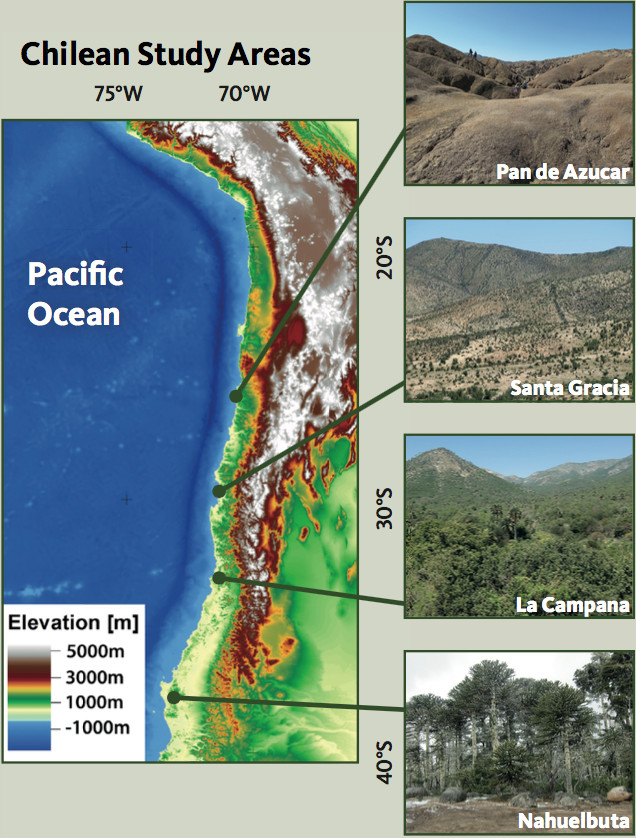

Field Sites:
The Chilean Coastal Cordillera, between 25° and 40°S is one of the very few regions on Earth with uniquely rich conditions for quantifying biotic interactions with topography. The primary reasons for this are the north-south orientation of the region such that it captures a large ecological and climate gradient, ranging from hyper-arid to temperate to humid conditions and, and it excludes glacial and periglacial environments to host mature soils. This gradient allows us to substitute time (in terms of IPCC climate change projections) with space (by using the prevailing north-south gradient in climate). Furthermore, the benefits for working in this area are:
|  |
Joint research efforts are focused around four primary areas (see also map above):
- National Park Pan de Azúcar
- Private Reserve Santa Gracia
- National Park La Campana
- National Park Nahuelbuta
Two secondary areas were defined, but no joint activities were realized in these areas during phase 1:
- Reserva Nacional Paposo
- Reserva Nacional Robleria del Cobre de Loncha
All six catchments have pristine vegetation that cover the climatic gradient. They span a range of climate and ecological zones that range from:
- Arid zone: The Reserva Nacional Paposo desert region with xeric shrublands is characterized by large variations in vegetation cover (bare to 70% vegetation cover); and Jurassic granitoid lithology (monzodiorites & granodiorite). The degree of weathering is low, except for areas of elevated moisture.
- Transition zone between semi-arid/Mediterranean to arid zones: This region represents a fragile forest to savanna biome (sclerophyllous forests, woodlands or scrub), at the dry limit of its climatic range. Vegetation is susceptible to recurring droughts, and the area is at the transition from complete to patchy vegetation cover. The lithology is Cretaceous granitoids (diorites, monzodiorites, and granodiorites), and the landscape is covered by thick regolith.
- Semi-arid/Mediterranean zone: This zone has sensitive vegetation with hydrophilous forests and evergreen sclerophyllous woodlands on shaded slopes and scrublands on exposed slopes; the same Jurassic granitoid lithology as zone 1 is present. Deeply weathered profiles are exposed along road cuts.
- Humid Temperate zone, lacking dry season: The Nahuelbuta national park is the last extensive remains of pristine temperate Araucaria forest. It is located on a deeply weathered Permo-Carboniferous granitic lithology (granodiorite, tonalite, and diorite).